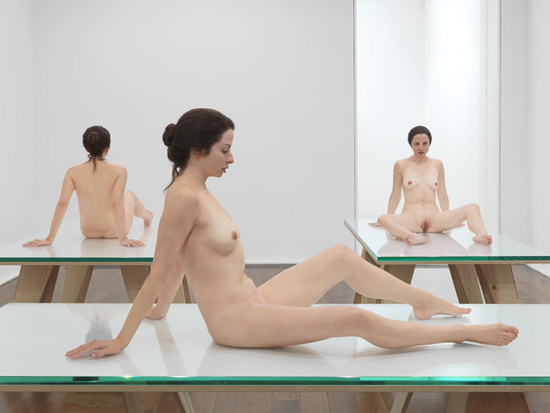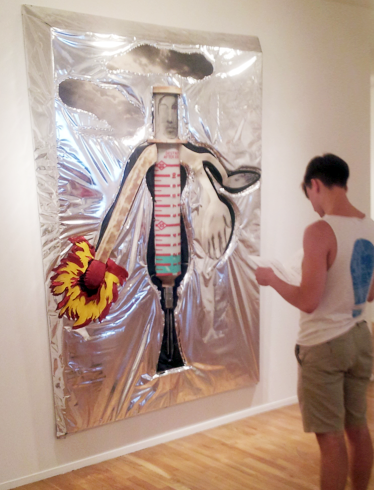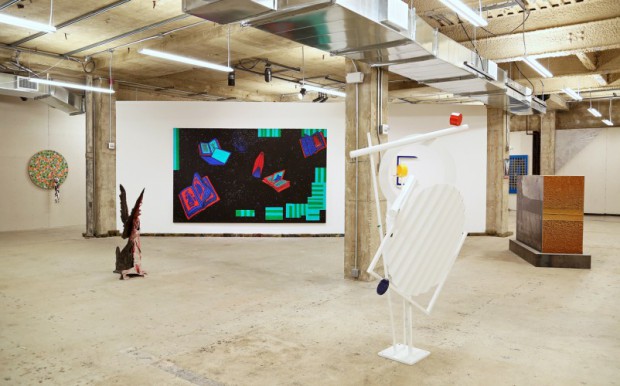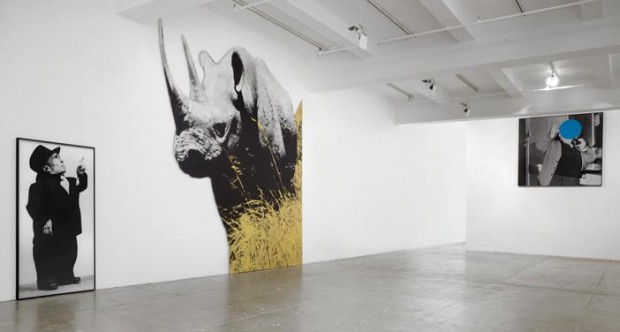We’re back! It’s been a while since we’ve given you a “We Went To,” but here we are to tell you about the best and worst of what’s on view on the Upper East Side. One fact became clear on this trip: John Baldessari has made a career out of oxymorons.
Our thoughts on Venus Over Manhattan, Higher Pictures, Hauser & Wirth, Marian Goodman, and Tibor de Nagy, below.
Paul McCarthy: Life Cast at Hauser & Wirth (32 East 69th Street)
Through July 26th
What’s on view: Hyperrealistic sculptures of Paul McCarthy and his muse, accompanied by videos about the sculpting process
Corinna Kirsch: Of all the Paul McCarthy shows we’ve seen in New York this year, this one’s my least favorite. We got some Jeff Koons appropriation at Frieze; some fecal play at Hauser & Wirth’s Chelsea location; and some bestiality-Americana at the New Museum. Here, we’ve just got some nudes.
Julia Wolkoff: Agreed. I hate to bring up the male gaze but isn’t everyone tired of the creepy voyeurism involved with observing the nude female in art? The first piece that you see walking into the gallery is That Girl (T.G. Asleep), a spread-eagle likeness of a nameless woman. Admittedly, the realism is incredibly done but I was so unimpressed by the content that I couldn’t bring myself to care about the process. The whole show came off as offensive and meaningless to me.
Corinna: Well, she might be nameless, but that girl is fairly well-known as Paul McCarthy’s muse, Elyse Poppers. I’m not particularly creeped out by the fact that these are realistic nudes; I’m uncomfortable with the working relationship going on here: McCarthy is Popper’s boss. Alongside appearing in his films, she works in his studio.
Mostly, I don’t really like these sculptures because they’re just Ron Muecks, minus the gigantism.
404 East 14th Street at Tibor de Nagy Gallery (724 5th Ave, 12th Floor)
Through August 2nd
What’s on view: A retrospective of work from the 1960s through the present, made by artists who have lived or worked at 404 East 14th Street
Corinna: When I first Googled the show’s address, 404 East 14th Street, a McDonald’s automatically popped up. Okay, I thought, maybe this will be an exhibition showing gentrification in action, from the freewheeling 1960s to the extravagant 1980s. Well, that’s only one part of the story. In addition to the 1960s, exemplified by the Claes Oldenburgs, the Yayoi Kusamas, and the John Chamberlains, there’s a Wes Anderson, a camping backpack design worn by a character in his 2012 film Moonrise Kingdom. So, the 404 East 14th Street building is now multi-use; whereas it used to be a central space for artists to gravitate, it’s now for anyone and everyone, from Oscar-winning filmmakers to Big Mac-lovers.
Back to the art, in my opinion, some of the stronger works in the show were by Larry Rivers.
I mean, what the fuck were we doing with our imagination prior to this amazing assemblage of a needle-spoon-match-woman-aluminum foil-cloudscape entered the world? We had nothing half as inventive or fanciful—although, to be fair, we were well on our way. Thanks, Duchamp. Thanks, LSD.
Clara Olshansky: I agree. I liked a lot of the whistles and bells, too. It was cool to see Allen Ginsberg’s notes for Things I’ll Not Do (Nostalgias), not that it added a terrible amount of poetic value to the work. I probably wouldn’t recommend 404 East 14th Street solely for its artistic merit, but I did love seeing it. It inspires the same combination of awe and envy that A Moveable Feast or reading about The Inklings does, knowing that there was a time and place in which some of the most creative minds of a generation used to just hang out and bounce ideas off each other in a fantasy land of artistic energy. If there hadn’t been, as you (Corinna) mentioned, sort of off-message things like the Wes Anderson prop (which, I concede, was the most Facebook-worthy piece on view), the whole effect could have worked really well.
Made in Space, curated by Peter Harkawik and Laura Owens at Venus Over Manhattan (980 Madison Avenue)
Through August 10th
What’s on view: A group show including dozens of works, mostly painting, by artists dealing with formal, spatial concerns; the exhibition has been split between Venus Over Manhattan and Gavin Brown’s Enterprise
Corinna: The show looks like the Independent. That makes sense given that painter Laura Owens, represented by Gavin Brown’s, is one of the show’s curators, and Gavin Brown’s tends to have standout booths at the fair. They’re the well-off, daredevil uncle admired by all the fair’s young Turks.
So, if you like the Independent, you’ll like this show. Don’t expect a Xerox copy of the fair, however; since both the show’s curators are from LA, they’ve included a handful of artists working out there, and a fair number of artists who I should have on my radar, like Lucas Blalock. That’s to the show’s benefit. I appreciated seeing artist Davida Nemeroff’s monumental, out-of-focus horse eye photograph; its scale gave the eye a nearly totemic status, and the blurriness made it seem like a peyote-induced hallucination.
Julia: I really see Made in Space as a counterbalance to all of the blockbuster museum shows happening in New York right now featuring heavyweight LA artists by showcasing some younger talent, several with little to no exhibition history in New York.
The survey of works isn’t cohesive, but they share a California vibe that I see as lacking in the New York contemporary scene. Altogether, Made in Space feels very 80s inspired. Derek Boshier‘s pop painting of books floating in space is Atari-influenced; Jim Isermann‘s boldly geometric wallpaper gives off the essence of a Trapper-Keeper; and Michael Decker‘s collage of animals with sunglasses has an adolescent glee. I often associate a 1980s aesthetic with a Bret Easton Ellis emptiness, but the show as a whole felt earnest.
A crack in this happy-go-lucky facade would have to be Venus Over Manhattan’s raw space (even if it’s fake raw), which is hard to get used to, given that it’s in such a monied hood.
Clara: Yeah, Made in Space definitely felt fresher than some of the major museum shows. At the door, I picked up a giant, free fake-newspaper filled with both some of the works from the show and a lot of supplemental materials. I think I’m enjoying it more than I enjoyed the show itself. For example, in the show there was a work that said, “Honey, I rearranged the collection on the top floor.” In the supplement, there are 18 iterations of “Honey, I rearranged the collection” including “Honey, I rearranged the collection according to artists who hate each other and who hate their dealers (that we also hate.)”
I liked a lot of the works on view, too, especially the Josh Mannis drawings. That said, it was all a lot to process, and felt a little disorganized.
Corinna: Clara, I get your organizational dissatisfaction. The show’s just as, but no more disorganized, than what you’ll see in that boothless fair. It doesn’t look like curation as much as say, a designer’s intervention.
Last thought: My eyes were pleased with the variety of shapes on view, which ranged from pastel squiggles, imperfect grids, and shark-toothed cut-outs. So, simple aesthetic pleasure won out.
John Baldessari Installation Works: 1987 – 1989 at Marian Goodman Gallery (24 W 57th Street, 4th Floor)
Through August 23rd
What’s on view: Three large-scale installation works featuring appropriated imagery and Baldessari’s signature dots
Clara: As installations, these rooms definitely evoke something—I’m just not sure what. I suppose there was a sort of hopefulness to Dwarf and Rhinoceros (with Large Black Shape) and Two Stories (Yellow and Blue) and Commentary (with Giraffe) was probably saying something about human’s relationship to primitive forms. That said, a lot of Baldessari’s decisions went over my head. (P.S. This video still exists and is still wonderful.)
Julia: At first glance, I agree that the decisions to group certain images seems arbitrary but my favorite aspect of the show was the free-form associations it allowed me to make. Just to give an overview of what was in each of the three galleries: a rhino, his shadow, and two black-and-white photographs of dwarves grace the first; a giraffe, some very un-PC photographs of tribal Africans and Western media projections of “jungle people” in the second; and polar bears, a man on fire, more animals, and movie stars with dotted out eyes are in the third.
To me, the preposterousness of these combinations reinforces the very tongue-in-cheek, self-loathing moments created in each gallery. Seeing my reflection in the print of the dwarf, I realized that he is taller, bigger, and more impressive than me. The half-naked 50s-era movie stars sit above four wild animals as pinnacles of American society.
The strange, exotic, and rare are brought together in an old-timey circus of appropriated images. Like a white cube safari, perhaps the gallery space is the real oddity.
Corinna: Maybe the secret is that it’s just really funny to see big dwarves. John Baldessari has made a career out of playing with oxymorons.
Clara: I think Baldessari has made a career out of just playing. Period.
Alfred Gescheidt: 30 Ways to Stop Smoking at Higher Pictures (980 Madison Avenue)
Through July
What’s on view: 30 black-and-white photographs by the late photographer, known for his experimental forays into editorial and advertising photography in the 1960s and 1970s.
Clara: Okay, so, this isn’t the most moving exhibition I’ll ever see. But I liked it! It’s fun, it’s goofy, and it was the perfect last show of the day, giving my mind a break. I mean, tell me “Find a Different Vice” isn’t funny.








Comments on this entry are closed.